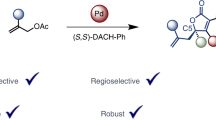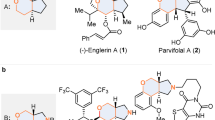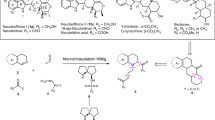Abstract
The stereodivergent synthesis of natural product frameworks via a single transformation using simple starting materials is a significant challenge. The prevalence of γ-butyrolactones in biologically active natural products has long motivated the development of enantioselective strategies towards their synthesis. Herein, we report an enantio- and diastereodivergent [3 + 2] annulation reaction for the synthesis of α,β-disubstituted γ-butyrolactones through cooperative N-heterocyclic carbene organocatalysis and iridium catalysis. This method overcomes the challenges of merging N-heterocyclic carbene organocatalysis with iridium catalysis by the appropriate choice of ligands. The use of two chiral catalysts allowed control over the relative and absolute configuration of the two formed stereocentres, thereby providing selective access to all four possible stereoisomers of the γ-lactone products. The transformation could be extended to the synthesis of δ-lactams via [4 + 2] annulation. The synthetic utility of this methodology was illustrated in the concise synthesis of the naturally occurring lignan (−)-hinokinin.
This is a preview of subscription content, access via your institution
Access options
Access Nature and 54 other Nature Portfolio journals
Get Nature+, our best-value online-access subscription
$29.99 / 30 days
cancel any time
Subscribe to this journal
Receive 12 digital issues and online access to articles
$119.00 per year
only $9.92 per issue
Buy this article
- Purchase on Springer Link
- Instant access to full article PDF
Prices may be subject to local taxes which are calculated during checkout







Similar content being viewed by others
Data availability
Crystallographic data for the structures reported in this Article have been deposited at the Cambridge Crystallographic Data Centre, under deposition numbers 1907670 ((R,S)-3c′) and 1907671 ((R,S)-6ab). Copies of the data can be obtained free of charge via https://www.ccdc.cam.ac.uk/structures/. All other data supporting the findings of this study are available within the article and its Supplementary Information, or from the corresponding author upon reasonable request.
References
Enders, D., Niemeier, O. & Henseler, A. Organocatalysis by N-heterocyclic carbenes. Chem. Rev. 107, 5606–5655 (2007).
Marion, N., Díez-González, S. & Nolan, S. P. N-Heterocyclic carbenes as organocatalysts. Angew. Chem. Int. Ed. 46, 2988–3000 (2007).
Izquierdo, J., Hutson, G. E., Cohen, D. T. & Scheidt, K. A. A continuum of progress: applications of N-hetereocyclic carbene catalysis in total synthesis. Angew. Chem. Int. Ed. 51, 11686–11698 (2012).
Flanigan, D. M., Romanov-Michailidis, F., White, N. A. & Rovis, T. Organocatalytic reactions enabled by N-heterocyclic carbenes. Chem. Rev. 115, 9307–9387 (2015).
Hopkinson, M. N., Richter, C., Schedler, M. & Glorius, F. An overview of N-heterocyclic carbenes. Nature 510, 485–496 (2014).
Zhang, C., Hooper, J. F. & Lupton, D. W. N-heterocyclic carbene catalysis via the α,β-unsaturated acyl azolium. ACS Catal. 7, 2583–2596 (2017).
Cardinal-David, B., Raup, D. E. A. & Scheidt, K. A. Cooperative N-heterocyclic carbene/Lewis acid catalysis for highly stereoselective annulation reactions with homoenolates. J. Am. Chem. Soc. 132, 5345–5347 (2010).
Raup, D. E. A., Cardinal-David, B., Holte, D. & Scheidt, K. A. Cooperative catalysis by carbenes and Lewis acids in a highly stereoselective route to γ-lactams. Nat. Chem. 2, 766–771 (2010).
Mo, J., Chen, X. & Chi, Y. R. Oxidative γ-addition of enals to trifluoromethyl ketones: enantioselectivity control via Lewis acid/N-heterocyclic carbene cooperative catalysis. J. Am. Chem. Soc. 134, 8810–8813 (2012).
Zhao, X., DiRocco, D. A. & Rovis, T. N-heterocyclic carbene and Brønsted acid cooperative catalysis: asymmetric synthesis of trans-γ-lactams. J. Am. Chem. Soc. 133, 12466–12469 (2011).
Xu, J. et al. Aminomethylation of enals through carbene and acid cooperative catalysis: concise access to β2-amino acids. Angew. Chem. Int. Ed. 54, 5161–5165 (2015).
Jin, Z., Xu, J., Yang, S., Song, B.-A. & Chi, Y. R. Enantioselective sulfonation of enones with sulfonyl imines by cooperative N-heterocyclic-carbene/thiourea/tertiary-amine multicatalysis. Angew. Chem. Int. Ed. 52, 12354–12358 (2013).
Wang, M. H., Cohen, D. T., Schwamb, C. B., Mishra, R. K. & Scheidt, K. A. Enantioselective β-protonation by a cooperative catalysis strategy. J. Am. Chem. Soc. 137, 5891–5894 (2015).
Zhuo, S. et al. Access to all-carbon spirocycles through a carbene and thiourea cocatalytic desymmetrisation cascade reaction. Angew. Chem. Int. Ed. 58, 1784–1788 (2019).
Wu, X. et al. Sulfinate and carbene co-catalyzed Rauhut–Currier reaction for enantioselective access to azepino[1,2-a]indoles. Angew. Chem. Int. Ed. 58, 477–481 (2019).
DiRocco, D. A. & Rovis, T. Catalytic asymmetric α-acylation of tertiary amines mediated by a dual catalysis mode: N-heterocyclic carbene and photoredox catalysis. J. Am. Chem. Soc. 134, 8094–8097 (2012).
Namitharan, K. et al. Metal and carbene organocatalytic relay activation of alkynes for stereoselective reactions. Nat. Commun. 5, 3982 (2014).
Chen, J., Yuan, P., Wang, L. & Huang, Y. Enantioselective β-protonation of enals via a shuttling strategy. J. Am. Chem. Soc. 139, 7045–7051 (2017).
Allen, A. E. & MacMillan, D. W. C. Synergistic catalysis: a powerful synthetic strategy for new reaction development. Chem. Sci. 3, 633–658 (2012).
Wang, M. H. & Scheidt, K. A. Cooperative catalysis and activation with N-heterocyclic carbenes. Angew. Chem. Int. Ed. 55, 14912–14922 (2016).
Liu, K., Hovey, M. T. & Scheidt, K. A. A cooperative N-heterocyclic carbene/palladium catalysis system. Chem. Sci. 5, 4026–4031 (2014).
Guo, C., Fleige, M., Janssen-Müller, D., Daniliuc, C. G. & Glorius, F. Cooperative N-heterocyclic carbene/palladium-catalyzed enantioselective umpolung annulations. J. Am. Chem. Soc. 138, 7840–7843 (2016).
Guo, C. et al. Mechanistic studies on a cooperative NHC organocatalysis/palladium catalysis system: uncovering significant lessons for mixed chiral Pd(NHC)(PR3) catalyst design. J. Am. Chem. Soc. 139, 4443–4451 (2017).
Singha, S., Patra, T., Daniliuc, C. G. & Glorius, F. Highly enantioselective [5 + 2] annulations through cooperative N-heterocyclic carbene (NHC) organocatalysis and palladium catalysis. J. Am. Chem. Soc. 140, 3551–3554 (2018).
Yasuda, S., Ishii, T., Takemoto, S., Haruki, H. & Ohmiya, H. Synergistic N-heterocyclic carbene/palladium-catalyzed reactions of aldehyde acyl anions with either diarylmethyl or allylic carbonates. Angew. Chem. Int. Ed. 57, 2938–2942 (2018).
Hoffmann, H. M. R. & Rabe, J. Synthesis and biological activity of α-methylene-γ-butyrolactones. Angew. Chem. Int. Ed. 24, 94–110 (1985).
Koch, S. S. C. & Chamberlin, A. R. in Studies in Natural Products Chemistry Vol. 16 (ed Rahman, A.-U.) 687-725 (Elsevier Science, 1995).
Seitz, M. & Reiser, O. Synthetic approaches towards structurally diverse γ-butyrolactone natural-product-like compounds. Curr. Opin. Chem. Biol. 9, 285–292 (2005).
Mao, B., Fañanás-Mastral, M. & Feringa, B. L. Catalytic asymmetric synthesis of butenolides and butyrolactones. Chem. Rev. 117, 10502–10566 (2017).
Sohn, S. S., Rosen, E. L. & Bode, J. W. N-heterocyclic carbene-catalyzed generation of homoenolates: γ-butyrolactones by direct annulations of enals and aldehydes. J. Am. Chem. Soc. 126, 14370–14371 (2004).
Burstein, C. & Glorius, F. Organocatalyzed conjugate umpolung of α,β-unsaturated aldehydes for the synthesis of γ-butyrolactones. Angew. Chem. Int. Ed. 43, 6205–6208 (2004).
Murauski, K. J. R., Jaworski, A. A. & Scheidt, K. A. A continuing challenge: N-heterocyclic carbene-catalyzed syntheses of γ-butyrolactones. Chem. Soc. Rev. 47, 1773–1782 (2018).
Burstein, C., Tschan, S., Xie, X. & Glorius, F. N-Heterocyclic carbene-catalyzed conjugate umpolung for the synthesis of γ-butyrolactones. Synthesis 2006, 2418–2439 (2006).
Douglas, J., Churchill, G. & Smith, A. D. NHCs in asymmetric organocatalysis: recent advances in azolium enolate generation and reactivity. Synthesis 44, 2295–2309 (2012).
Cheng, Q. et al. Iridium-catalyzed asymmetric allylic substitution reactions. Chem. Rev. 119, 1855–1969 (2019).
Krautwald, S., Sarlah, D., Schafroth, M. A. & Carreira, E. M. Enantio- and diastereodivergent dual catalysis: α-allylation of branched aldehydes. Science 340, 1065–1068 (2013).
Krautwald, S. & Carreira, E. M. Stereodivergence in asymmetric catalysis. J. Am. Chem. Soc. 139, 5627–5639 (2017).
Beletskaya, I. P., Nájera, C. & Yus, M. Stereodivergent catalysis. Chem. Rev. 118, 5080–5200 (2018).
Waldeck, B. Biological significance of the enantiomeric purity of drugs. Chirality 5, 350–355 (1993).
Teichert, J. F. & Feringa, B. L. Phosphoramidites: privileged ligands in asymmetric catalysis. Angew. Chem. Int. Ed. 49, 2486–2528 (2010).
Defieber, C., Ariger, M. A., Moriel, P. & Carreira, E. M. Iridium-catalyzed synthesis of primary allylic amines from allylic alcohols: sulfamic acid as ammonia equivalent. Angew. Chem. Int. Ed. 46, 3139–3143 (2007).
He, M., Uc, G. J. & Bode, J. W. Chiral N-heterocyclic carbene catalyzed, enantioselective oxodiene Diels−Alder reactions with low catalyst loadings. J. Am. Chem. Soc. 128, 15088–15089 (2006).
Marcotullio, C. M., Pelosi, A. & Curini, M. Hinokinin, an emerging bioactive lignan. Molecules 19, 14862–14878 (2014).
Timple, J. M. V. et al. The lignan (−)-hinokinin displays modulatory effects on human monoamine and GABA transporter activities. J. Nat. Prod. 76, 1889–1895 (2013).
Gil, A., Albericio, F. & Álvarez, M. Role of the Nozaki–Hiyama–Takai–Kishi reaction in the synthesis of natural products. Chem. Rev. 117, 8420–8446 (2017).
Ye, K.-Y., Cheng, Q., Zhuo, C.-X., Dai, L.-X. & You, S.-L. An iridium(I) N-heterocyclic carbene complex catalyzes asymmetric intramolecular allylic amination reactions. Angew. Chem. Int. Ed. 55, 8113–8116 (2016).
Yang, Z.-P., Jiang, R., Zheng, C. & You, S.-L. Iridium-catalyzed intramolecular asymmetric allylic alkylation of hydroxyquinolines: simultaneous weakening of the aromaticity of two consecutive aromatic rings. J. Am. Chem. Soc. 140, 3114–3119 (2018).
Bao, C.-C., Zheng, D.-S., Zhang, X. & You, S.-L. Iridium/N-heterocyclic carbene complex-catalyzed intermolecular allylic alkylation reaction. Organometallics 37, 4763–4772 (2018).
Kaeobamrung, J., Kozlowski, M. C. & Bode, J. W. Chiral N-heterocyclic carbene-catalyzed generation of ester enolate equivalents from α,β-unsaturated aldehydes for enantioselective Diels–Alder reactions. Proc. Natl. Acad. Sci. USA 107, 20661–20665 (2010).
Bhaskararao, B. & Sunoj, R. B. Origin of stereodivergence in cooperative asymmetric catalysis with simultaneous involvement of two chiral catalysts. J. Am. Chem. Soc. 137, 15712–15722 (2015).
Acknowledgements
Support for this work was generously provided by the Deutsche Forschungsgemeinschaft (Leibniz Award) and the European Union’s Horizon 2020 research and innovation programme under the Marie Skłodowska-Curie grant agreement number 843349-H2020-MSCA-IF-2018 (E.S.). We also thank M. J. James, M. van Gemmeren, T. Patra and Z. Nairoukh (University of Münster) for helpful discussions and corrections during the preparation of the manuscript. M. Wollenburg, M. Wiesenfeldt, T. Wagener, K. Kronenberg and N. Radhoff (University of Münster) are acknowledged for experimental support.
Author information
Authors and Affiliations
Contributions
S.S., E.S., S.M. and F.G. designed, performed and analysed the experiments. C.G.D. performed the crystallographic studies. S.S., E.S. and F.G. co-wrote the manuscript. All authors contributed to discussions.
Corresponding author
Ethics declarations
Competing interests
The authors declare no competing interests.
Additional information
Publisher’s note Springer Nature remains neutral with regard to jurisdictional claims in published maps and institutional affiliations.
Supplementary information
Supplementary information
Supplementary methods, Tables 1–7, Figures 1–8, references
Compound (R,S)-3c
′ Crystallographic data for compound (R,S)-3c′
Compound (R,S)-6ab
Crystallographic data for compound (R,S)-6ab
Rights and permissions
About this article
Cite this article
Singha, S., Serrano, E., Mondal, S. et al. Diastereodivergent synthesis of enantioenriched α,β-disubstituted γ-butyrolactones via cooperative N-heterocyclic carbene and Ir catalysis. Nat Catal 3, 48–54 (2020). https://doi.org/10.1038/s41929-019-0387-3
Received:
Accepted:
Published:
Issue Date:
DOI: https://doi.org/10.1038/s41929-019-0387-3
This article is cited by
-
Catalytic stereodivergent allylic alkylation of 2-acylimidazoles for natural product synthesis
Nature Communications (2023)
-
Silver/chiral pyrrolidinopyridine relay catalytic cycloisomerization/(2 + 3) cycloadditions of enynamides to asymmetrically synthesize bispirocyclopentenes as PDE1B inhibitors
Communications Chemistry (2023)
-
Biomimetic asymmetric catalysis
Science China Chemistry (2023)
-
Desymmetrization of N-Cbz glutarimides through N-heterocyclic carbene organocatalysis
Nature Communications (2022)
-
Stereodivergent propargylic alkylation of enals via cooperative NHC and copper catalysis
Nature Communications (2022)



